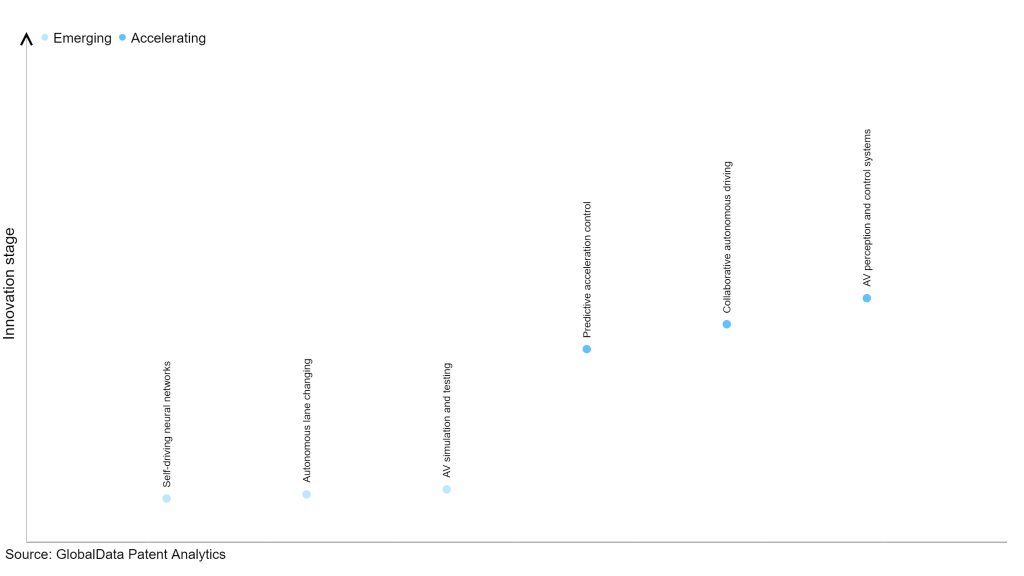The automotive industry continues to be a hotbed of patent innovation. Activity is driven by by safety, cost, performance, and convenience. Autonomous vehicles (AVs) improve road safety by accurately detecting their surroundings, reducing production costs, enhancing performance in diverse conditions, and revolutionizing transportation. These systems enable vehicles to operate safely and autonomously in real-world scenarios, making them more efficient and reliable, ultimately reducing the overall cost of AV production. The automotive industry is utilizing advanced technologies such as deep learning, multi-sensor fusion, predictive control, and edge computing for AVs. These technologies enable AVs to perceive and respond safely, navigate their environment efficiently, and make real-time decisions, paving the way for more sophisticated systems. In the last three years alone, there have been over 720,000 patents filed and granted in the automotive industry, according to GlobalData’s report on Artificial intelligence in automotive: AV perception and control systems. Buy the report here.
However, not all innovations are equal and nor do they follow a constant upward trend. Instead, their evolution takes the form of an S-shaped curve that reflects their typical lifecycle from early emergence to accelerating adoption, before finally stabilizing and reaching maturity.
Identifying where a particular innovation is on this journey, especially those that are in the emerging and accelerating stages, is essential for understanding their current level of adoption and the likely future trajectory and impact they will have.
300+ innovations will shape the automotive industry
According to GlobalData’s Technology Foresights, which plots the S-curve for the automotive industry using innovation intensity models built on over one million patents, there are 300+ innovation areas that will shape the future of the industry.
Within the emerging innovation stage, self-driving neural networks, autonomous lane changing and AV simulation and testing are disruptive technologies that are in the early stages of application and should be tracked closely. Predictive acceleration control, collaborative autonomous driving, and AV perception and control systems are some of the accelerating innovation areas, where adoption has been steadily increasing.
Innovation S-curve for artificial intelligence in the automotive industry

AV perception and control systems is a key innovation area in artificial intelligence
AV perception and control systems refer to a set of technologies that enable autonomous vehicles to perceive and interpret their surroundings and take appropriate actions to navigate safely. The systems typically use a combination of sensors, such as cameras, LiDAR, and radar, along with machine learning algorithms, to detect and classify objects, understand road markings and traffic signals, and make decisions based on real-time information.
GlobalData’s analysis also uncovers the companies at the forefront of each innovation area and assesses the potential reach and impact of their patenting activity across different applications and geographies. According to GlobalData, there are 575+ companies, spanning technology vendors, established automotive companies, and up-and-coming start-ups engaged in the development and application of AV perception and control systems.
Key players in AV perception and control systems – a disruptive innovation in the automotive industry
‘Application diversity’ measures the number of applications identified for each patent. It broadly splits companies into either ‘niche’ or ‘diversified’ innovators.
‘Geographic reach’ refers to the number of countries each patent is registered in. It reflects the breadth of geographic application intended, ranging from ‘global’ to ‘local’.
Patent volumes related to AV perception and control systems
Source: GlobalData Patent Analytics
Intel is one of the leading patent filers in AV perception and control systems for the automotive industry. One of the latest patents Intel has filed is for a system and method for training AVs to navigate complex environments. The system uses a deep learning algorithm to predict other vehicles' and pedestrians' behavior, and a reinforcement learning algorithm to train the AV to navigate safely and efficiently. The system is designed to be deployed in a simulation, where the AV learns from the simulation to navigate the real world safely. The patented technology could potentially improve the safety and performance of AVs in real-world conditions. Sony Group and NVIDIA are some of the other key patent filers in this area.
In terms of application diversity, Crown Equipment leads the pack. Tractable and The Saudi Public Investment stood in the second and third positions respectively. By means of geographic reach, Intel held the top position followed by Tractable and Walmart.
To further understand the key themes and technologies disrupting the automotive industry, access GlobalData’s latest thematic research report on Artificial Intelligence (AI) in Automotive.
Data Insights
From

The gold standard of business intelligence.
Blending expert knowledge with cutting-edge technology, GlobalData’s unrivalled proprietary data will enable you to decode what’s happening in your market. You can make better informed decisions and gain a future-proof advantage over your competitors.



